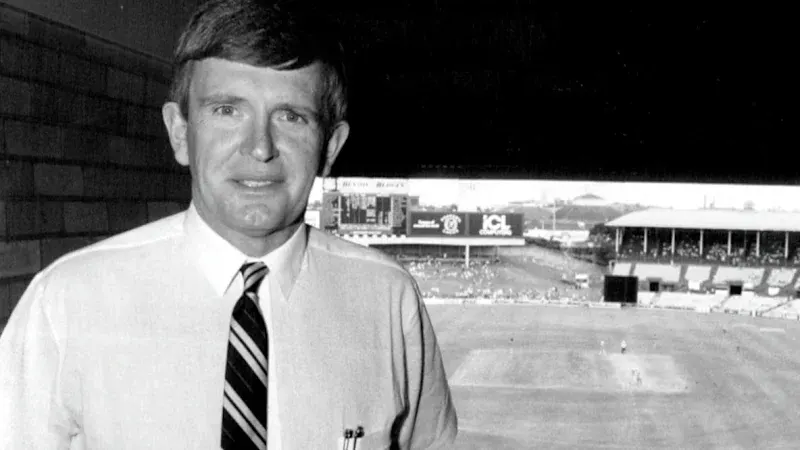Before the advent of Big Bash and Bazball, Australian cricketer Keith Stackpole, who has passed away at the age of 84, was an exceptionally audacious and aggressive opening Test batsman from 1966 to 1974.
His remarkably audacious approach at the top of the order was particularly highlighted by the juxtaposition of his Test performance as an opener beside the contrastingly staid presence of Bill Lawry, who was impervious to the joys of rapid run accumulation.
Stackpole, a robustly aggressive antithesis to Lawry’s slender caution, largely disregarded the long-standing defensive principles of opening batsmanship, opting instead to use every opportunity to strike the ball forcefully across the field.
“If an opponent delivered a half-pitched ball wide of me on the first delivery in a Test match, I would refrain from playing a shot and observe it pass by,” stated Lawry. “However, Stacky would merely flatten his ears and propel it through the gully for four.”
Before the comprehensive transformation of the game by one-day cricket, such audacious endeavors were not entirely unprecedented, as evidenced by the aggressive England batsman Colin Milburn. Nevertheless, it was a novelty that distinguished Stackpole.
His approach was exceptionally efficient in 43 Tests, solidifying his status as one of Australia’s most reliable run scorers in the early 1970s and contributing to his ascension to vice-captaincy. Subsequently, he became a radio and television pundit, in addition to serving as a newspaper columnist in Melbourne.
Stackpole was born in the Collingwood region of Melbourne to Hannah (née Dunn), a homemaker, and Keith Sr, a first-class cricketer for Victoria, who was more renowned as an Australian Rules player for Collingwood and Fitzroy.

Following Keith Jr’s demonstration of his cricketing prowess at Christian Brothers College in Clifton Hill, the careers of father and son intersected momentarily when they competed together for the Collingwood club in 1957—senior participating in his final match while junior was making his debut.
While significantly influenced by his father, a robust attacking batsman, Stackpole also benefited from the mentorship of Jack Ryder, a veteran of Collingwood and former Australia captain, who enhanced the young player’s game without suppressing his innate aptitude for back-foot play or his inclination to drive the ball square on both sides of the wicket.
By 1960, he made his first-class debut for Victoria, and by 1963, he had secured his position in the team, typically batting at No. 3. He made his Test debut in the lower middle order against England in Adelaide in 1966, scoring 43 in his sole innings and taking the wickets of Colin Cowdrey and MJK Smith with his sporadic leg breaks—performances that warranted his selection for the 1966-67 tour to South Africa.
Notwithstanding a formidable first Test century at No. 7 in Cape Town, his performances during that tour were unexceptional, and he maintained a generally mediocre standard until a significant breakthrough occurred in early 1969. At that time, Captain Lawry, seeking a successor for his lately retired opening partner Bobby Simpson, opted to elevate Stackpole in the batting order against the West Indies in Sydney.
In his new role, he achieved three half-centuries in his initial four innings, sealing his fate. He served as an opener for the final 33 matches of his Test career.
By averaging 46 in the 1969-70 series in India, Stackpole emerged as a crucial element in Australia’s infrequent series victory there. His worth was unequivocally affirmed during England’s 1970-71 tour of Australia, where he recorded scores of 207 in the first Test in Brisbane, 136 in the fifth in Adelaide, and a series of other commendable innings, culminating in a total of 627 runs at an average of 52.25.
Ken Burley Obituary: Town Planner Who Built Doncaster Future Passes Away at 80.
Lawry relinquished the captaincy to Ian Chappell during the sixth match of that protracted, unsuccessful seven-Test series. Chappell and Stackpole established a robust alliance during the subsequent drawing series in England in 1972. Stackpole, now vice-captain, maintained his prolific success with the bat, surpassing all other Australians in Test runs throughout the trip, achieving five half-centuries and one century, with an average of 53.88. As a consequence, Wisden designated him one of its five cricketers of the year in 1973.
By that time, in his early 30s, he served as vice-captain for two additional seasons with Australia, culminating in two series triumphs—one in the West Indies in 1972-73 and another in Australia against New Zealand in 1974—succeeded by a 1-1 draw in three matches in New Zealand (also in 1974). His final test in Auckland concluded on a rather subdued note, as he was removed for 0 in both innings, resulting in a Test batting average of 37.42.
His final international appearance was in a 35-over match after that trip, marking one of just six one-day matches he participated in. Despite being well-suited to the short format of cricket, he experienced frustration during its early days due to the inability of most other players to comprehend its entertaining potential.
Stackpole’s illustrious career concluded in 1974, culminating in a Sheffield Shield victory for Victoria as captain, complementing his previous triumphs in 1967 and 1970. He accumulated a total of 10,100 runs with an average of 39.29 and claimed 148 wickets. He was appointed MBE shortly after his retirement.
His media career commenced with an offer to commentate on Kerry Packer’s World Series cricket in 1977, subsequently leading to a three-decade tenure in broadcasting with the Nine and Seven networks, culminating in his retirement from ABC in 2005. He additionally mentored other players at Victoria, notably Dean Jones and Brad Hodge.
His spouse, Pat, and their children, Peter, Tony, and Angela, survive him.